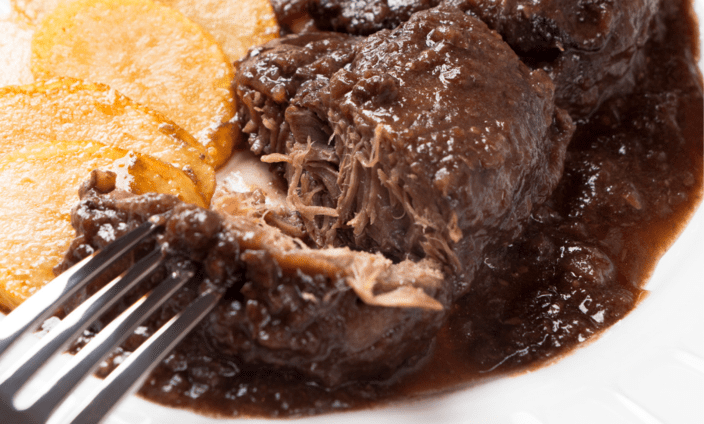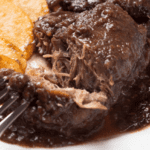Ox Cheek Stew Recipe
Recipe by
Campbells
3-6 hours
Serves 2
Ingredients
For the Stew
- 2 Ox Cheeks, Feather Blade, or Braising Steak (500g per person for a large meal)
- 2 sticks of celery, very finely diced
- 2 carrots, very finely diced
- 2 onions, very finely diced
- 4 cloves of garlic, crushed then chopped finely
- 1/2 to 3/4 bottle of red wine (doesn’t need to be expensive wine but something full bodied like a Merlot or Cabernet is ideal)
- 500ml beef stock
- Sprig of thyme
- 2 bay leaves
- Oil
Method
Step 1 : Preheat the Oven
If using a casserole dish and oven, first preheat your oven to 150C/Gas Mark 2.
Put just enough oil in a casserole dish or heavy bottomed pan to coat the pan and heat to a medium high temperature, high enough to sear meat. If you will be using a slow cooker you can simply use any pot or dish that will fit the vegetables and ox cheeks as you will sear the meat and cook the vegetables for a bit first before transferring.
Step 2 : Sear the Ox Cheek
Take one ox cheek, featherblade, or braising steak, and place in the pot. It should immediately start to sizzle and the skin sear and turn crisp and brown, if it does not you will need to continue heating the oil up until it does.
Take each ox cheek, featherblade, or braising steaks one by one and sear each side for a minute or two until browned. The searing and browning of meat to add flavour is called the Maillard reaction, and is a result of heat breaking down amino acids, proteins, and sugars found within food.
Remove the meat and put to the side.
Step 3 : Cook the Vegetables
In the same pot add your finely chopped celery, carrots, and onion and cook until softened. Be careful not to burn the vegetables and lower the heat if necessary. This basic cooking mix of ingredients and technique is a staple in French cuisine and is called Mirepoix.
Step 4 : Add Garlic
Once the vegetables soften, add in your finely chopped garlic and stir through the vegetables thoroughly for a few minutes.
Step 5 : Add Seared Ox Cheek
If using a slow cooker transfer the vegetables to the bottom of the slow cooker and place the ox cheek, featherblade, or braising steak on top. If using a casserole dish you can simply add the ox cheeks on top of the vegetables now and switch off the heat.
Add the wine and beef stock with abandon. Add the thyme and bay leaves.
Step 6 : Slow Cook
If using a casserole dish add the lid and place in the oven. Cook for 4 hours until the ox cheeks fall apart and are extremely tender. If using a slow cooker cook on a low heat for 5 to 6 hours. If using braising steak or feather blade cook for 3 hours.
You can remove the lid and simmer the sauce for a few minutes to thicken, or if you want to imitate restaurants simply remove the meat and bay leaves then blend the sauce. When serving add the blended sauce on top of the meat. You can use a fork to break up the ox cheeks, featherblade, or braising steak, or serve whole.
Step 7 : Serve
Serve with mashed potato mixed with black pudding and tender stem broccoli.
Our Ox Cheek Stew Recipe is incredibly easy and also very versatile if you decide to experiment with some of the optional ingredients listed above at a later date. In fact, this stew is so versatile it can also be used to make a Braising Steak Stew, and a Feather Blade Stew. This is a delicious, hearty, and warming stew that is a perfect comfort food dish while also being impressive enough to dazzle guests. In fact, the cooking method makes it ideal for dinner parties as the stew can be left to its own devices for most of the cooking time and thus does not need to be watched over constantly, and can also be made in advance. This stew freezes well and can be kept in a freezer for up to three months.
We love serving this Ox Cheek Stew Recipe with winter greens, and it works very well with potatoes cooked in any fashion. One of our favourite options is lightly cooked tenderstem broccoli and creamy mashed potato mixed with a generous helping of black pudding (or even haggis!). You can make this stew with a slow cooker or in a casserole dish.








